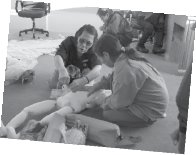One way to approach a literacy and oral history program is to make it an
intergenerational project. Literacy group members can work side by side with their
children for parts of the project. As well, their parents, aunts and uncles or other
relatives may be valuable resources to an oral history project.
What is Intergenerational or Family Literacy?
Intergenerational Literacy, sometimes called ‘Family Literacy’, is the ways families
use language skills, literacy skills and cultural information to do day-to-day tasks, to
keep important traditional and cultural knowledge alive.
At the Pauktuutit Annual General Meeting in October 2000 delegates discussed
literacy issues. They saw some challenges to Inuktitut language and culture.
Inuktitut and Inuit culture are being eroded for many reasons:
- More people have TV in their homes.
- More parents speak to their children in English and children speak more
English.
- Inuit who can speak English tend to use it a lot.
- Fewer people go to church, which used to be a place outside of school where
people read and could learn to read in Inuktitut.
- Problems at home make it difficult for children to learn.
Pauktuutit delegates felt it was important to support the idea of approaching
literacy development through children and families.
Traditional family patterns support an intergenerational approach:
- The bond between parents and children is a natural one.
- It is traditional for children to treat their Elders with respect.
- It is traditional for Inuit to treat their children with respect.
- Elders want to work with children to strengthen Inuit language and culture.
Intergenerational approaches can enhance community development and wellness.
Supporting literacy, language and culture through children and families is one way
to raise the quality of people’s lives by:
- strengthening family and community bonds;
- improving family communication and the ability to network with others;
- increasing people’s ability to keep jobs and prevent problems related to
unemployment;
- supporting community survival and create a progressive, healthy community;
- creating educational resources by documenting the talents and traditional
knowledge of Inuit;
- improving individual self-esteem which can make families healthier;
- providing interactive alternatives to TV that strengthen relationships between
Elders and children; and
- involving more parents in their children’s learning and schooling.

